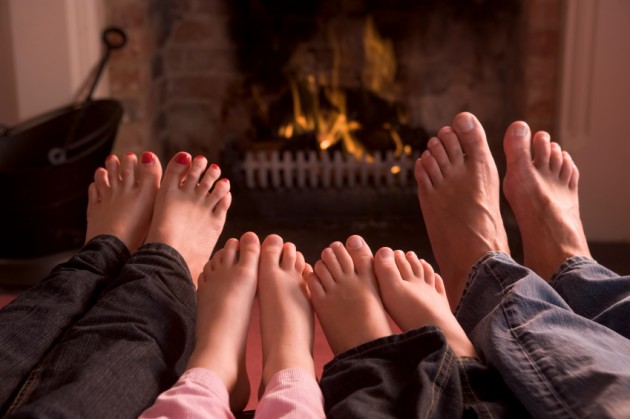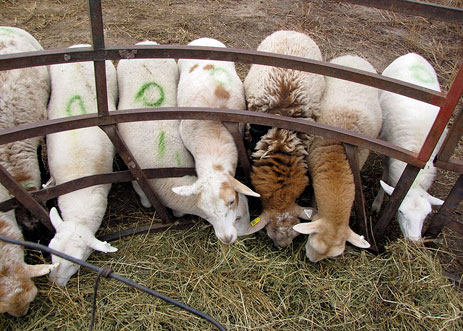
The medium chill: Get off the aspirational treadmill and into a hammock.
Mother Jones has an interesting package up called “Speedup: Working More, Making Less.” In the lead story, editors Monika Bauerlein and Clara Jeffery chronicle the harrowing pace of modern work life: the long hours and hairy commutes, multitasking and endless accessibility, the sense of always being busy, always falling behind, always doing a crappy job on both sides of the work/life ledger.
Bauerlein and Jeffery discuss the phenomenon mainly in terms of external forces acting on workers — a system of laws and regulations comprehensively biased in favor of employers. And that’s where the main focus should be; policy changes are the stuff of organizing and politics. But it reminded me I’ve been meaning to write something about the other side, the internal forces impelling us to work harder and harder. We are being driven, but we are also driving ourselves. Finding saner, happier, more sustainable lives will involve addressing both sides of the equation.
About a year ago, I was visiting with an old friend of mine who lives in Portland now. He’s helping to run a tech startup, working 80-hour weeks, half that on the road, with barely enough time at home to maintain a relationship with his dog, much less a romance. The goal, he said, is to grow like crazy, get bought out by Google, and retire at 40. “It’s the big chill, man!” (No, Boomers, not the movie.)
I shook my head and laughed. “I’ll take the medium chill!”
Ever since then I’ve been mulling that concept over. By way of approaching it, I’m going to talk a little about personal experience, so if that kind of thing bugs you, skip on down, there’s some social science geekery below.
Personal chill
“Medium chill” has become something of a slogan for my wife and me. (We might make t-shirts.) We’re coming up on 10 years married now, but we recognized our mutual love of medium chill within weeks of meeting, about the time we found ourselves on her couch watching scratchy bootleg VHS tapes of The Sopranos I ordered off eBay, drinking Two Buck Chuck, and loving life. We just never knew what to call it.
We now have a smallish house in a nondescript working class Seattle neighborhood with no sidewalks. We have one car, a battered old minivan with a large dent on one side where you have to bang it with your hip to make the door shut. Our boys go to public schools. Our jobs pay enough to support our lifestyle, mostly anyway. If we wanted, we could both do the “next thing” on our respective career paths. She could move to a bigger company. I could freelance more, angle to write for a bigger publications, write a book, hire a publicist, whatever. We could try to make more money. Then we could fix the water pressure in our shower, redo the back patio, get a second car, or hell, buy a bigger house closer in to town. Maybe get the kids in private schools. All that stuff people with more money than us do.
But … meh. It’s not that we don’t think about those things. The water pressure thing drives me batty. Fact is, we just don’t want to work that hard! We already work harder than we feel like working. We enjoy having time to lay around in the living room with the kids, reading. We like to watch a little TV after the kids are in bed. We like going to the park and visits with friends and low-key vacations and generally relaxing. Going further down our respective career paths would likely mean more work, greater responsibilities, higher stress, and less time to lay around the living room with the kids.
So why do it? There will always be a More and Better just beyond our reach, no matter how high we climb. We could always have a little more money and a few more choices. But as we see it, we don’t need to work harder to get more money to have more choices because we already made our choice. We chose our family and our friends and our place. Like any life ours comes with trade-offs, but on balance it’s a good life, we’ve already got it, and we’re damn well going to enjoy it.
That’s the best thing about the medium chill: unlike the big chill, you already have it. It’s available today, at affordable prices!
Medium but difficult chill
The medium chill involves what economists call satisficing: abandoning the quest for the ideal in favor of the good-enough. It means stepping off the aspirational treadmill, foregoing some material opportunities and accepting some material constraints in exchange for more time to spend on relationships and experiences.
It turns out, though, that satisficing doesn’t come easy to us human beings. We have an extremely hard time saying, “okay, this is good enough.” Why?
Part of the reason is that we hate closing off opportunities, and that’s what satisficing feels like. We like to keep our options open in case something better comes along.
But will a better thing make us happier? We’re inclined to think, “of course it would!” But that’s because, as social psychologists have come to understand quite well, we’re not very good at predicting what will make us happy. In fact, we suck at it.
Most of all, we radically overestimate the impact of external events, both positive and negative. We think winning the lottery would vault us into bliss and losing a limb in an accident would leave us permanently depressed, but neither is true. Experiments and surveys show that within a year, a lottery winner and an amputee will be roughly as happy as they were before events struck. We drift back to our natural equilibrium fairly quickly. This is counterintuitive and difficult to accept at first, but the implications are profound.
We also underestimate the significance of our internal resources. We cannot control events, but we can, at least to some degree, control our reactions to events. It is possible to become more positive, open, and empathetic, to cultivate a resilient wellbeing that weathers changing circumstances. It’s been done! For an exhaustive account, see Martin Seligman’s Flourish.
To sum up: the bad news is that it’s unlikely any job advance, material acquisition, or singular event will make you durably happier; the good news is that it’s possible to make yourself durably happier without any new job, material acquisition, or singular event.
In the video above, Dan Gilbert calls the kind of happiness we find through external events “natural happiness” and the kind we generate for ourselves “synthetic happiness.” As he says, we tend to disdain synthetic happiness, as though it’s a species of delusion. People who are happy that way are “fooling themselves.” Their happiness is not as authentic as happiness that arises in response to events. But Gilbert’s (and others’) work has shown pretty clearly that synthetic happiness is more accessible and durable than “natural” happiness and just as, well, happy. Your brain doesn’t know the difference.
 Social connections are key to happiness.Money vs. chill
Social connections are key to happiness.Money vs. chill
The U.S. economy is built on our error about what will make us happy. In fact, the error is built right into economics. To an economist, the economic actor finds happiness through the satisfaction of preferences, and the more choices we have, the more likely we are to be able to satisfy our preferences. That’s why economists use money as a rough stand-in for wellbeing; wealth represents choices.
That’s what consumer culture forever tells us: more money/stuff/status means fewer constraints, more freedom, more choices, thus more happiness. The entire economy runs on spending and debt, and for that to work everyone needs to think they’re not happy but could be happy if they just had more sh*t or a better job or a better house. Every “consumer” needs to be running on the treadmill, working toward the next thing.
But social psychology tells a different story. There’s very little evidence that, once a certain base level of material security is achieved, more money and stuff make us happier. Gilbert offers one explanation: having fewer choices is often more conducive to synthetic happiness. (Watch the video — he’s got some fascinating experiments to back this up.) Piling up choices can make contentment impossible.
If that’s true, the implications for consumer culture are fairly profound.
Connected chill
Consider: Why do we always remember our childhood friends? Why do so many people look back on college with fondness? Why are so many married couples nostalgic for those hardscrabble early years, with the crappy jobs and tiny apartment and borrowed baby clothes? It’s because, while those environments were materially constrained (we had fewer choices), they yielded powerful relationships. We made the best of what we had, which is an intense psychosocial process that leads to deep bonds and enduring memories.
On this point, social scientists are all but unanimous: social connections are at the heart of wellbeing. We’re happier, and our happiness is more resilient, when we are woven into a social fabric: when we have a devoted life partner, supportive networks of family and friends, and larger communities of which we are a valued part. Even having a pet helps. The good life is a life rich in relationships.
Yet millions of Americans devote themselves to making more money, buying more stuff, accruing more status, dissolving more constraints, and having more choices, even at the expense of social connections. It’s not making us happier, so why do we do it to ourselves?
The rat race vs. chill
The answer lies in what’s called social proof: we look to our peers, our tribe, for cues on how we ought to behave. Status and wealth are comparative; we judge ourselves not by how we’re doing but how we’re doing compared to the Joneses. If our peers are buying big houses and second cars and private schools, our strong instinct is to want to signal our status by doing the same.
And in America, no matter how much you’ve got, someone next to you has more. This is what Chris Hayes once described to me as “fractal inequality.” America’s top 10 percent are far, far better off than the other 90 percent, but the top 1 percent is far, far better off than the 10 percent, and the 0.01 percent is far, far better off than the 1 percent. And so on. The U.S. is slowly dividing into two nations, one that can’t get what it needs and one that has everything and always wants more.
That’s how you get people in the U.S. making $200,000 a year — unquestionably rich relative to the median — whining that they’re just humble middle class. They look with bitter envy on those making a million, just as those making a million aspire to the tens of millions, and so on. That’s how you get a media and political class at once privileged and put-upon, swimming in wealth relative to the average American but forever rubbing shoulders with those who are even richer.
There is no plateau, no place to stand where you’re not looking up at your next-door neighbors. And thanks to the magic of television, every family in the country gets to compare themselves to the richest of the rich every single night.
Getting to medium chill
Whatever policy or technological advances we may see in coming decades, some part of getting to sustainability is going to be voluntarily living with less space and stuff. We’re going to have to scale down our material expectations and get off the aspirational treadmill. So how can we do that? How can we make satisficing a respected choice, even a source of status itself? How can we make it okay to prioritize social connections over money and choice hoarding?
Good questions! I sure wish more people were thinking and talking about it. This post is already way too long, but I’ll conclude with two tentative thoughts about the answers.
First, we won’t get there through shame and guilt. We won’t get there by morally bullying people into giving up stuff they love. People will only downscale materially if they are also upscaling in social connections and positive experiences. So rather than focusing on the former, let’s focus on the latter. We have all sorts of infrastructure and institutions available for people who want to learn how to get a better job or make more money. But we have lamentably little for people who want to know how to foster more and better relationships, how to find meaning and a sense of accomplishment.
Second, if you’re going to de-emphasize the material in favor of the social, you’re going to be talking about places. If we want people to own and consume less privately, we need to provision safe, accessible, pleasant public spaces and resources. But you probably knew I’d say that.
Anyway, that’s the medium chill. I’d love to hear your thoughts and, best of all, your stories about what the medium chill looks like in your life.
[Editor’s note, May 1, 2013: David Roberts is revisiting the medium chill. Read his new thoughts on the subject.]


